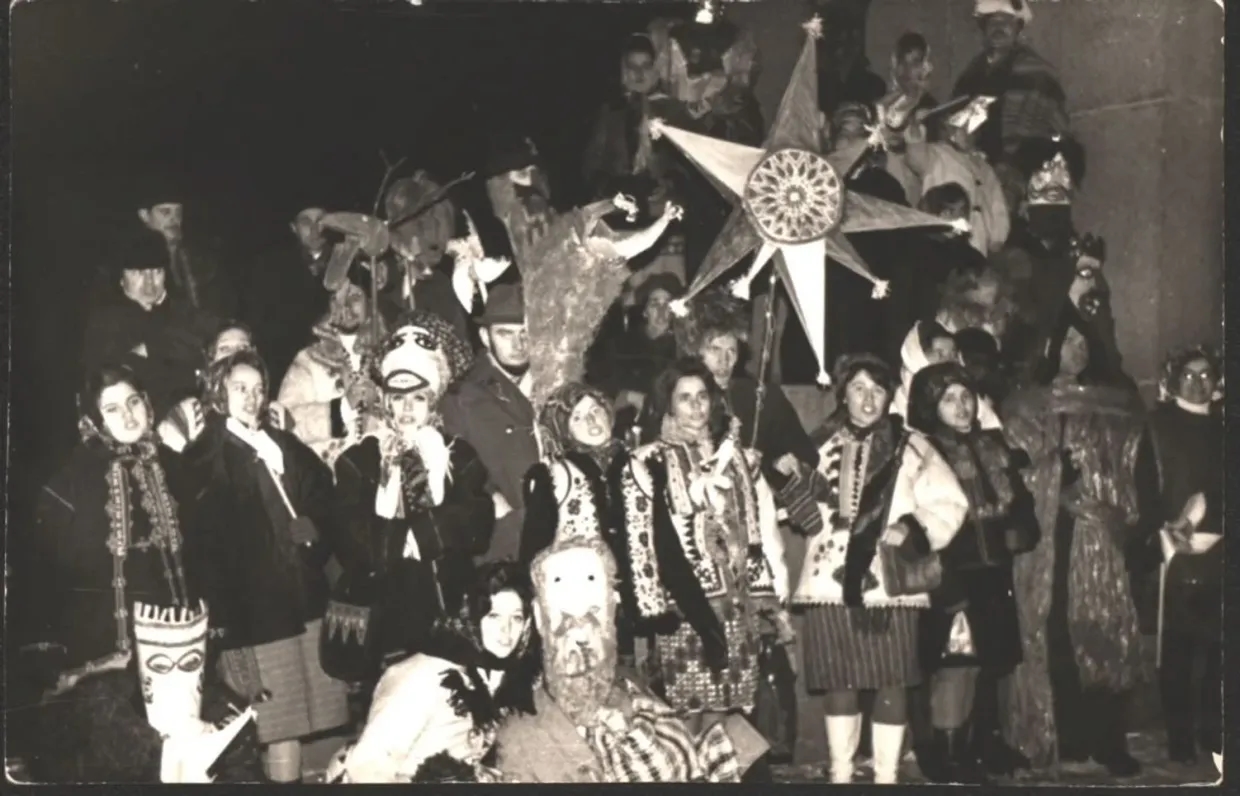The elements of Vertep. (Albina Kolesnichenko / The Kyiv Independent)
Editor's note: For the holiday season, the Kyiv Independent has created a unique collection dedicated to Vertep. Shop now on our e-store.
On New Year’s Eve in 1972, a group of Ukrainians set out to carol — a seemingly innocent holiday tradition. But for the KGB, the Soviet Union’s security services, this was no ordinary celebration. As the carolers moved from house to house, their movements were tracked.
The artists and human rights activists that went caroling that night were part of a group known collectively as the Shistdesiatnyky, or Sixtiers in English, for the decade they produced their most celebrated work.
The group championed Ukrainian culture and called for social justice in an era defined by Soviet repression. Many of them, including the poet Vasyl Stus, were arrested.

The KGB wasn’t following the group that night for just any caroling — it was Vertep, a centuries-old Christmas tradition that has historically been as political as it is aesthetic, embodying centuries of Ukrainian folk culture.
The tradition dates back to the 16th-17th centuries and is still practiced across Ukraine today around the Christmas and New Year’s holidays.
Originally staged as a traveling puppet theater, it is now performed by carolers who dress up in elaborate costumes and sing songs blending religious and folk themes. The colorful casts can include up to 40 characters, ranging from religious figures, shepherds, and peasants to animals.
What are the origins of Vertep?
The precise origins of Vertep remain somewhat of a mystery, even for scholars of Ukrainian folk traditions. Some suggest it arrived in Ukraine from western Europe, though people have differing views on exactly where it began. In western Europe, puppet theaters with religious themes — like miracle plays depicting saints’ lives — had captivated audiences since the Middle Ages.

Before the second half of the 18th century, when the earliest known text for a Vertep performance was written, this tradition existed as an oral art form. Students of the Kyiv-Mohyla Academy — Ukraine's oldest university founded in 1615 — most likely played a pivotal role in its rise to prominence during the 18th century.
By adapting and enriching Vertep with elements of Ukrainian cultural life, the students transformed it into a dynamic expression of local identity and cultural tradition.
All of this unfolded within the Ukrainian Baroque, a vibrant era in Ukraine’s history spanning the late 16th to 18th centuries. Shaped by the influence of the Cossacks — a semi-nomadic warrior society and early champions of Ukrainian independence — this period wove together ideas of resilience and a flourishing of artistic and intellectual life, leaving a lasting imprint on the nation’s cultural and political identity.
How is Vertep performed?
The Vertep theater was traditionally envisioned as a two-tiered wooden structure designed to separate the sacred from the secular. The upper level was for the staging of religious performances, while the lower level was reserved for secular works, ranging from somber tragedies to lively comedic satires. These performances were enhanced by carols or instrumental music, adding a rich auditory dimension to the storytelling.
Over the centuries, Vertep evolved but remains a cherished embodiment of the Christmas spirit. Modern celebrations can feature caroling groups adorned in traditional Ukrainian folk costumes or dressed as characters from folklore. These groups often incorporate brief theatrical skits into their caroling, paying homage to Vertep’s historical roots. A striking centerpiece of the spectacle is the elaborately crafted star (“zvizda”), symbolizing the Star of Bethlehem that guided the Magi to the nativity.
Vertep performances boast a diverse cast of characters. Notably, the first documented performance, recorded in Poltava Oblast in the late 18th century, included 35 characters.
In his 1929 scholarly study “Ukrainian Vertep,” Yevhen Markovskyi delves into a number of historical versions of the tradition, including the Baturyn Vertep, one of the earliest known renditions. Baturyn, located in modern-day Chernihiv Oblast, was a thriving cultural hub and the capital of the Cossack Hetmanate during the tenure of Hetman Ivan Mazepa.

The Baturyn Vertep brought together a rich array of characters, including Christ in the manger, the Virgin Mary and Joseph, shepherds, and angels, as well as King Herod, the archangel Michael, and also Death. The narrative's religious focus centered on the nativity scene, while its secular elements introduced a cast that included a Cossack hero, a young couple, a Romani fortune teller, an elderly Jewish man and woman, soldiers, and a beggar.
The Cossack hero in Vertep serves as a powerful symbol of Ukrainian cultural resilience. Pious and courageous yet undeniably charismatic, his performance often brims with humor, adding a dynamic layer to the narrative. At his essence, however, the Cossack embodies the triumph of good over evil, standing as a timeless representation of strength, righteousness, and Ukrainians’ enduring spirit.
The use of satire in Vertep provided a powerful means to confront and publicly critique social injustices. Corrupt noblemen demanding the tribute of the peasantry are not only ridiculed but also often outwitted, effectively subverting the oppressive structures of the social hierarchy.
The exaggerated selfishness of these privileged figures served as a comedic tool, but it also highlights their moral shortcomings. In contrast, characters such as the Cossack offer a model for how individuals should rise above the temptations of vice with regard to themselves and their communities.
Stay warm with Ukrainian traditions this winter. Shop our seasonal merch collection.
Exemplifying Ukrainian resilience
Given its progressive nature, the Soviet regime actively sought to wipe out Vertep, along with other Ukrainian Christmas traditions, such as Malanka, from public life. Religious practices were viewed as a direct challenge to the state's Communist ideology, threatening the party's control over the cultural and ideological fabric of society.
In an effort to promote a more secular state, the Soviets strategically elevated holidays like New Year’s Eve, deliberately sidelining Christmas to reshape Ukraine’s cultural identity and suppress its religious roots.
It could be argued that once these traditions were labeled as disruptive, they embraced that very designation, as many Ukrainians, resolute in their commitment to preserving their cultural heritage, resisted such efforts.
Despite Soviet attempts to suppress them, many Ukrainians succeeded in safeguarding their Christmas traditions. However, the authorities also exploited this resistance as a pretext to target individuals, intensifying their crackdown on cultural expression, such as when the caroling Sixtiers were arrested.


Those who have endeavored to document the Vertep tradition over the centuries have uncovered not only how Ukrainians have preserved this cultural legacy but also how they have enriched it with their own distinct interpretations.
Each version of Vertep adds a new layer to the Ukrainian storytelling tradition, further enriching the tapestry of Ukrainian culture and deepening the collective identity of its people.
As a writer, 19th-century author Ivan Franko was deeply captivated by the history of Vertep, appreciating not only its rich folk heritage but also its incisive satire, which elegantly critiqued social injustices with both wit and boldness. He understood that trying to capture the diversity of Vertep was vital to preserving the experiences of Ukrainians from all walks of life, especially those who had endured the brutal realities of Russian aggression throughout the centuries.
“I have no doubt that every newly unearthed text, rescued from oblivion, will contribute at least a small line to the history of our Vertep,” Franko wrote in “Toward a History of Ukrainian Vertep” in 1906.
“For this reason, they will be recorded, even if only as fragments of our history preserved in folk memory.”
Note from the Kyiv Independent:
At the Kyiv Independent, this tradition inspired us to create our winter collection this year. We’ve taken this cherished custom — the vibrant Vertep puppet theater — and reimagined them in a series of unique designs. The collection, an intricate tapestry of symbols, brings to life the spirit of Vertep, blending faith and folklore in celebration of Ukrainian Christmas.
Stay warm with Ukrainian traditions this winter. Shop our seasonal merch collection.















